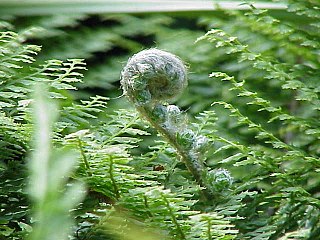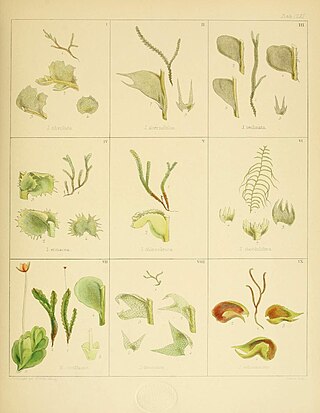
Botrychium is a genus of ferns, seedless vascular plants in the family Ophioglossaceae. Botrychium species are known as moonworts. They are small, with fleshy roots, and reproduce by spores shed into the air. One part of the leaf, the trophophore, is sterile and fernlike; the other, the sporophore, is fertile and carries the clusters of sporangia or spore cases. Some species only occasionally emerge above ground and gain most of their nourishment from an association with mycorrhizal fungi.

Sceptridium is a genus of seedless vascular plants in the family Ophioglossaceae, closely allied to the genus Botrychium. It is also closely related to the genus Botrypus. Sceptridium species are commonly called the grape-ferns.

Polystichum is a genus of ferns in the family Dryopteridaceae, subfamily Dryopteridoideae, according to the Pteridophyte Phylogeny Group classification of 2016. The genus has about 500 species and has a cosmopolitan distribution. The highest diversity is in eastern Asia, with about 208 species in China alone; the region from Mexico to Brazil has at least 100 additional species; Africa, North America, and Europe have much lower diversity. Polystichum species are terrestrial or rock-dwelling ferns of warm-temperate and montane-tropical regions. They are often found in disturbed habitats such as road cuts, talus slopes, and stream banks.

Astereae is a tribe of plants in the family Asteraceae that includes annuals, biennials, perennials, subshrubs, shrubs, and trees. They are found primarily in temperate regions of the world. Plants within the tribe are present nearly worldwide divided into over 250 genera and more than 3,100 species, making it the second-largest tribe in the family behind Senecioneae.

Bazzania is a genus of liverwort in the family Lepidoziaceae.

Calypogeia is a genus of liverworts in the family Calypogeiaceae.
Schistochila is a genus of liverworts in the order Jungermanniales. It is the only genus in the family Schistochilaceae.
Triniochloa is a genus of Latin American plants in the grass family.

Geophila is a genus of herbs in the family Rubiaceae. This genus is pantropical, as it is found in most tropical regions.

Marsupella is a liverwort genus in the family Gymnomitriaceae.

Cephaloziaceae is a family of liverworts.

The Botany of Lord Auckland's Group and Campbell's Island is a description of the plants discovered in those islands during the Ross expedition written by Joseph Dalton Hooker and published by Reeve Brothers in London between 1844 and 1845. Hooker sailed on HMS Erebus as assistant surgeon. It was the first in a series of four Floras in the Flora Antarctica, the others being the Botany of Fuegia, the Falklands, Kerguelen's Land, Etc. (1845–1847), the Flora Novae-Zelandiae (1851–1853), and the Flora Tasmaniae (1853–1859). They were "splendidly" illustrated by Walter Hood Fitch.
Lophozia is a genus of liverworts belonging to the family Lophoziaceae.

Jungermannia is a genus of leafy liverworts belonging to the family Jungermanniaceae. They have a worldwide distribution.
Odontoschisma is a genus of liverworts belonging to the family Cephaloziaceae.

Solenostoma is a genus of liverworts belonging to the family Solenostomataceae.

Mannia is a genus of liverworts belonging to the family Aytoniaceae. It has a cosmopolitan distribution.

Lophocolea is a genus of liverworts belonging to the family Lophocoleaceae. The genus has a cosmopolitan distribution.














